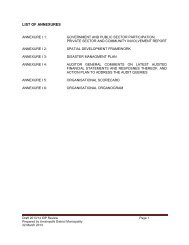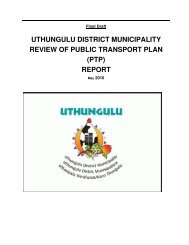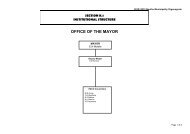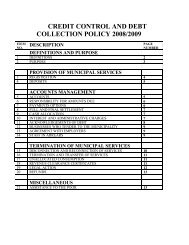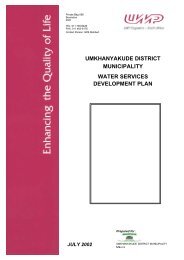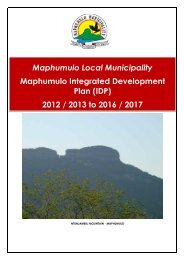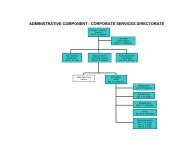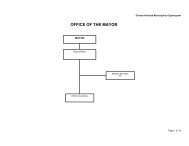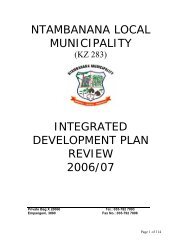Final Adopted IDP - KZN Development Planning
Final Adopted IDP - KZN Development Planning
Final Adopted IDP - KZN Development Planning
You also want an ePaper? Increase the reach of your titles
YUMPU automatically turns print PDFs into web optimized ePapers that Google loves.
(viii) that negative impacts on the environment and on people‟s environmental rights be<br />
anticipated and prevented and, where they cannot be altogether prevented, are<br />
minimised and remedied.<br />
Section 2(4)(b) of NEMA prescribes that environmental management must be<br />
integrated, acknowledging that all elements of the environment are linked and<br />
interrelated, and it must take into account the effects of decisions on all aspects of the<br />
environment and all people in the environment by pursuing the selection of the best<br />
practicable environmental option.<br />
National Spatial <strong>Development</strong> Perspective<br />
The National Spatial <strong>Development</strong> Perspective (NSDP) is an initiative by the National<br />
Government to provide direction and guidelines for spatial planning in order to ensure<br />
the eradication of the spatially segregated growth pattern that still exists today. The<br />
NSDP guides government in implementing its programmes in order to achieve the<br />
objectives of Accelerated and Shared Growth – South Africa (ASGI-SA) of halving<br />
poverty and unemployment by 2014. The NSDP is built on five basic principles:<br />
Principle 1: Rapid economic growth that is sustained and inclusive as a prerequisite for<br />
the achievement of poverty alleviation;<br />
Principle 2: Government has a constitutional obligation to provide basic services to all<br />
citizens (for example water, energy, health and educational facilities) wherever they<br />
reside;<br />
Principle 3: Government spending on fixed investment should be focused on localities of<br />
economic growth and / or economic potential in order to gear up private sector<br />
investment, stimulate sustainable economic activities and create long-term employment<br />
opportunities;<br />
Principle 4: Where low economic potential exists investments should be directed at<br />
projects and programmes to address poverty and the provision of basic services in order<br />
to address past and current social inequalities;<br />
Principle 5: In order to overcome the spatial distortions of Apartheid, future<br />
settlement and economic development opportunities should be channeled into activity<br />
corridors and nodes that are adjacent to or link the main growth centres in order for<br />
them to become regional gateways to the global economy.<br />
16



